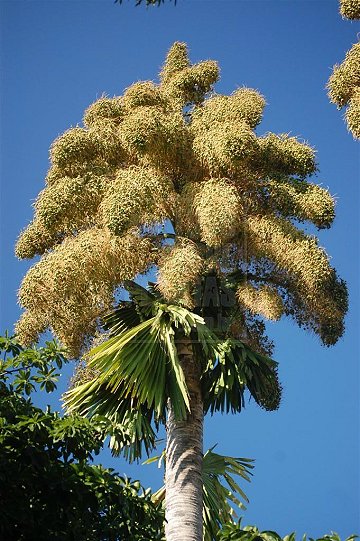
|
|
Talipot palm
(Corypha umbraculifera).
|
Talipot palm - Corypha umbraculifera
Corypha umbraculifera, the talipot palm, is a species of palm native to eastern and southern India and Sri Lanka. It is also grown in Cambodia, Myanmar, China, Thailand and the Andaman Islands. It is a flowering plant with the largest inflorescence in the world. It lives up to 60 years before bearing flowers and fruits. It dies shortly after.
It is one of the largest palms with individual specimens having reached heights of up to 25 m. The plant's single stem is straight and cylindrical, 100 - 130cm in diameter and ringed with prominent leaf scars.
The stem is unbranched and is topped by a crown of immense, fan-like leaves. It is a fan palm (Arecaceae tribe Corypheae), with large, palmate leaves up to 5 m in diameter, with a petiole up to 4 m, and up to 130 leaflets.
One of its huge leaves can shelter more than ten people from the rain!
The talipot palm bears the largest inflorescence of any plant, 6–8 m (20–26 ft) long, consisting of one to several million small flowers borne on a branched stalk that forms at the top of the trunk (the titan arum, Amorphophallus titanum, from the family Araceae, has the largest unbranched inflorescence, and the species Rafflesia arnoldii has the world's largest single flower). The talipot palm is monocarpic, (the inflorescence is terminal, dies after flowering),
flowering only once, when it is 30 to 80 years old. It takes about a year for the fruit to mature, producing thousands of round, yellow-green fruit 3–4 cm (1–1.5 in) in diameter, each containing a single seed.
They are golf ball-sized fruits that rain down for several weeks when ripe. The plant dies after fruiting.
The talipot palm is a very slow-growing palm, it is widely cultivated as an ornamental tree in the tropics.
The talipot palm is cultivated in South India and Sri Lanka. It is also cultivated in Southeast Asian countries of Cambodia, Myanmar, Thailand and the Andaman Islands. It is also grown sparsely in China.
Local people have a wide range of uses for this palm, gathering food, medicines and other commodities for their use from wild trees.
The sap of the inflorescence can be used for making sugar. The immature endosperm of the seed can be made into a sweetmeat. The fully ripe endosperm cannot be eaten.
An edible starch can be obtained from the trunk. It is made into a flour and used for making bread.
The juice from the root is used for curing diarrhoea. A decoction of the young stems is used for curing hot rheum.
The leaves are strong and durable. They are used for a variety of purposes, including thatching, making fans, mats, umbrellas and tents. The leaves are also used for thatching, and the sap is tapped to make palm wine.
Strips of the leaves can be used like paper for writing on. At one time, sacred Hindu and Buddhist texts used to be written on them.
Historically, the leaves were written upon in various South Asian and South-East Asian cultures using an iron stylus to create palm leaf manuscripts.
A fibre obtained from the stem is soft and pliable. The report does not make it clear if the leaf stem or the main trunk are being referred to.
In recent times the leaf media has been used by traditional healers and soothsayers. The petioles can be used in the manufacture of canes, arrows and netting needles. At low tide, fishers use the fruit to stupefy fish.
The hard seeds are used like ivory to make beads, buttons, ornaments etc.
Source:
https://en.wikipedia.org/wiki/Corypha_umbraculifera
https://tropical.theferns.info/viewtropical.php?id=Corypha+umbraculifera
https://www.rarepalmseeds.com/corypha-umbraculifera
